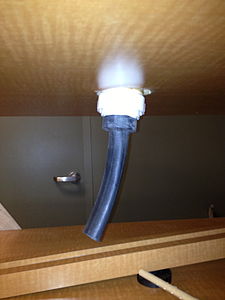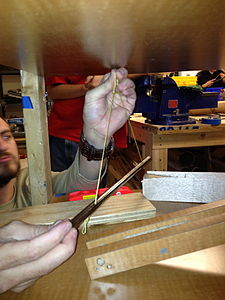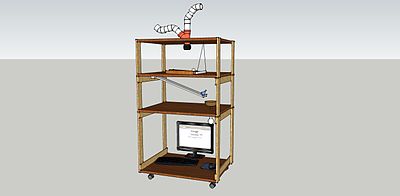Engineering Projects/Rube Goldberg/Howard Community College/Fall2012/p2-504-fcrd
Electronic Sections Expected
[edit | edit source]









Problem Statement
[edit | edit source]Build a Rube Goldberg machine with an Engineering theme for Club Rush Spring 2013
Team Members
[edit | edit source]Summary
[edit | edit source]Put an overall, short one paragraph summary here.
Poster
[edit | edit source]Story
[edit | edit source]First two weeks
[edit | edit source]- Making Hole in 2nd Level We made this hole so it can connect the 2nd level to the 3rd level.
- Using the electronic jigsaw We used the electronic jigsaw to make the hole bigger.
- Using the dremel In order for the hole to be smooth we needed to use a dremel.
- Dremel being used to make the brace We needed to make a brace in order to sustain the pipe properly in the first level.
- Cutting a pipe with a Hacksaw
- Cutting sides of thin wood In order to make the brace we used a thin wood where we cut the sides (10cm each side)
- Cutting sides of thin wood part 2
- Making hole in thin wood
- Using dremel in the thin wood
- Using dremel (Becca)
- Using dremel (Freddy)
- Cutting with electronic jigsaw a piece of wood
For the first week we discussed thoroughly how to get the different levels of the structure to interact. We came up with ideas of how this could happen. Our first choice was to have holes where one step of the Rube Goldberg would fall into the next. This seemed like the easiest way of connecting the levels, and since the shelves were strategically drilled to the braces, we could take them off, make the hole and then put them back together.We decided to make the hole in one of the corners, because we found that the ball falling into one of the sides, and not in the middle for some of the levels, would better use up the space of the structure. Freddy also looked at materials that could be used for the second level of the Rube Goldberg. Since the first idea was to make a bridge, we looked around to see how this could be made. We were also considering that instead of a bridge, an aluminum tube, which is pretty malleable, could be used. Chad looked at the first level of the Rube Goldberg, and how to start the machine in a way that would be pleasing to an audience. He worked on gathering materials such as pvc pipes, balls, and pieces of wood which would be used on the first level. Rebecca worked on gathering materials which could be used to initiate a chemical reaction on the third level of the machine. We discussed ways in which to get the second and third levels to work together. Daniel worked on the arduino.
For the second week the hole of level two was made. After discussing with the team, we finally came up with the decision that the hole should be in a side rather than in the middle. This way it would fit better with the sketch made for level three. We took off the shelve of level two, and measuring two inches from the side, we drew a circle following the size of the 2" pvc pipe, and we started making the hole. The hole was made first with the drill and the hole saw. Since this tool makes only small holes, we had to make it bigger with an electronic jigsaw, and after using it the hole was not smooth so we used a dremel and made the surface smoother. After making the hole in the shelve of level two, we put it back together of the structure of the Rube Goldberg. There is a detailed list of steps documented in videos on the team page. Individually, we worked on the materials which would make our machine work properly.
After doing the hole in level two, Chad needed a brace that would hold the 2" pvc pipe that goes through the hole in the first level, so while he was working on his level, Becca and Freddy worked on making this brace. We used some thin wood that was in the ENES lab, and we drew a circle wide enough to cover the 2" pvc pipe, after this we measured 10 cm from each side. We first cut the sides of the thin wood with an electronic jigsaw. We alternated the task between Becca and Freddy so we could both have some experience with these kind of tools. Then, we made the hole with the drill with hole saw, but since the hole was not wide enough we had to make it bigger. Since the wood was too thin, we could not use the electronic jigsaw because it would break it and the hole would not be smooth, so we went ahead and used that dremel for this part. After making the hole, we cut the brace in half and Chad drilled it to the first level so it could be used for the brace that will hold the 2" pvc pipe of the first level. Meanwhile, Chad had several pieces of pvc pipe and a couple of pvc elbows that he put together to form the ramps that the ball would travel through on the first level. Daniel continued to work on the arduino portion of the project.
We also started working on a sketch in Google Sketch Up for the second level.
Freddy worked thoroughly on my Google Sketch Up designs. In the design it can be appreciated the actual structure of the Rube Goldberg, with all of the braces, and holes. He also made the design to scale. He took the measurements of each of the parts of the Rube Goldberg, and made sure that when he was making the model of the Rube Goldberg every part of it was with its right measurement. This way when we introduced new parts to the design it will be easier to see how it actually would look like.
The first design is of the Rube Goldberg of how it actually is, with the braces and the first part of level one.
All of this work was done over the weekend; however, when we met on campus there was a lot of on-hands work done. We started by playing around with the materials that we had in the Engineering lab and putting them in different places to see how they reacted. We collected some materials that we thought were going to be useful. Chad had three pin ball balls that we were using to make our reactions, we started by putting one ball in the pipe in level 1 and saw how this ball would fall down in different ways. Freddy started playing around with the position of it, but the ball was so unpredictable that each time it fall, it would fall in a different place. We then saw a rubber tube and we thought that we could use that to guide the ball and absorb some of the initial velocity and besides this, with the rubber tube we could direction in an accurate way the position of the ball when it falls. After innumerable attempts we finally succeed at predicting where the ball would fall. We then, put a ramp in the place where the ball falls, and when we threw the ball down the pipe it fall into the ramp. After succeeding in this two parts, we thought of ways to make the second level more exciting. We had found a thin metal tube, attached to a string on each side, we came with the idea of using this tube in a way that would connect the ramp with some other reaction, like a swing arm. We came with the idea of using another ramp that would make the ball fall into the third level, and we thought of integrating the steel tube with this.
Last two weeks
[edit | edit source]- First Time testing the parts of the Rube Goldberg
- Second attempt
- Successful attempt
- First attempt when everything went right
- When we discovered that the ball made a spiral when it came down the tube
- The fun of Rube Goldberg Machines
- Spiral occurred and balls went perfectly
- One problem that always occurred
- The ball got stuck in the rubber tube
- Side View of Second level
- Last Attempt of 11/07/2012
Freddy continued to work thoroughly on my Google Sketch Up designs. He worked on showing the team's vision for the whole project. Chad also worked on how he wanted the Rube Goldberg to start, developing plans for a spring like that on a pinball machine, which would initiate our machine. Rebecca, after spending some days testing different materials to initiate a simple reaction between baking soda and vinegar, decided we could use a ramp that a pinball would fall on to knock over a flask of vinegar into an awaiting bowl of baking soda. We found that it would be a good idea to rig the bowl to pull down into the final level of the structure in order to go into the next step of the machine.We would need springs under the bowl to make this happen. We gathered our materials for this portion of the machine, and began planning how to make this happen. Daniel continued working on the arduino, and tried to figure out which programs would better get our final end result, a display sowing the words Join Engineering Club, to show up. We finalized our work by finishing up our documentation concerning what we learned over the course of our project.
Becca Cutting the rubber tube
[edit | edit source]Rubber tube and pipe
[edit | edit source]Setting up the Structure
[edit | edit source]Side View
[edit | edit source]Sketch for next group
[edit | edit source]Decision List
[edit | edit source]Material List
[edit | edit source]Soldering gun
acid core solder
4-6 1/8"x48" steel rods
4 45* 2" pvc elbows
2" pipe bracing
1 1/16" stainless steel mirror finish pinballs (2)
Arduino
[edit | edit source]This is the sample code that we will be using for computer engineering. This will control the keyboard and mouse of the computer if the push-buttons on the breadboard are touched.
/*
KeyboardAndMouseControl
Controls the mouse from five pushbuttons on an Arduino Leonardo and Arduino Due.
Hardware:
* 5 pushbuttons attached to D2, D3, D4, D5, D6
The mouse movement is always relative. This sketch reads
four pushbuttons, and uses them to set the movement of the mouse.
WARNING: When you use the Mouse.move() command, the Arduino takes
over your mouse! Make sure you have control before you use the mouse commands.
created 15 Mar 2012
modified 27 Mar 2012
by Tom Igoe
this code is in the public domain
*/
// set pin numbers for the five buttons:
// set pin numbers for the five buttons:
const int upButton = 2;
const int downButton = 3;
const int leftButton = 4;
const int rightButton = 5;
const int mouseButton = 6;
void setup() { // initialize the buttons' inputs:
pinMode(upButton, INPUT);
pinMode(downButton, INPUT);
pinMode(leftButton, INPUT);
pinMode(rightButton, INPUT);
pinMode(mouseButton, INPUT);
Serial.begin(9600);
// initialize mouse control:
Mouse.begin();
Keyboard.begin();
}
void loop() {
// use serial input to control the mouse:
if (Serial.available() > 0) {
char inChar = Serial.read();
switch (inChar) {
case 'u':
// move mouse up
Mouse.move(0, -40);
break;
case 'd':
// move mouse down
Mouse.move(0, 40);
break;
case 'l':
// move mouse left
Mouse.move(-40, 0);
break;
case 'r':
// move mouse right
Mouse.move(40, 0);
break;
case 'm':
// move mouse right
Mouse.click(MOUSE_LEFT);
break;
}
}
// use the pushbuttons to control the keyboard:
if (digitalRead(upButton) == HIGH) {
Keyboard.write('u');
}
if (digitalRead(downButton) == HIGH) {
Keyboard.write('d');
}
if (digitalRead(leftButton) == HIGH) {
Keyboard.write('l');
}
if (digitalRead(rightButton) == HIGH) {
Keyboard.write('r');
}
if (digitalRead(mouseButton) == HIGH) {
Keyboard.write('m');
}
}
Software List
[edit | edit source]'Google SketchUp
Time
[edit | edit source]41.5 hours
Next Steps
[edit | edit source]Assemble the parts of the second level. Put together the parts of the third level that will follow the reaction of the ball in the second level. Figure out how the springs of the third level will function in order to push down the button that presses a key that makes the arduino react and shows the message of JOIN ENGINEERING CLUB.
















